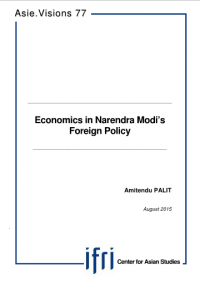Gateway to Think Tanks
| 来源类型 | Publications - Policy Papers - Asie Visions |
| 规范类型 | 简报 |
| DOI | 978-2-36567-430-0 |
| Economics in Narendra Modi’s Foreign Policy Asie.Visions, No. 77, August 2015 | |
| Amitendu PALIT | |
| 发表日期 | 2015-08-31 |
| 出处 | Asie Visions |
| 出版年 | 2015 |
| 概述 | A distinct feature of Prime Minister Narendra Modi’s first year in office was the remarkable speed and alacrity with which he moved on external engagement. During his first twelve months as Prime Minister, he travelled to almost twenty countries in different parts of the world. Indeed, Modi... |
| 摘要 |
Economics in Narendra Modi’s Foreign Policy Asie.Visions, No. 77, August 2015
A distinct feature of Prime Minister Narendra Modi’s first year in office was the remarkable speed and alacrity with which he moved on external engagement. During his first twelve months as Prime Minister, he travelled to almost twenty countries in different parts of the world. Indeed, Modi appeared to be guided by the impression that high rates of economic growth cannot be generated only by domestic policies and initiatives.  These need to be matched by external engagement that, apart from serving geo-strategic imperatives, would be economically proactive by enabling greater exchange of goods and services and fostering business collaborations between India and the rest of the world. As this paper points out, the drivers of Modi’s foreign policy are embedded in the objectives of domestic economic growth and expansion of the Indian economy. These drivers primarily aim to facilitate India’s economic turnaround and consolidate its comparative advantages in several key industries for expanding India’s share in global production over time. In this regard, the paper emphasizes the importance of ‘Make in India’, Modi’s signature initiative for transforming India into a global hub for several manufacturing and services industries. It also analyses Modi’s efforts to rectify India’s supply–side deficiencies, particularly its limited access to energy and argues that building nuclear energy capacities has become an important objective of the Modi government’s external outreach. Another important driver of Modi’s external engagement is the diaspora. This is a ‘natural’ engagement given the BJP’s strong links with the overseas Indian community and the political and financial leverages it draws from the links. The paper points to the multiple significance of the Diaspora, including improving India’s global image and extracting greater strategic benefits from bilateral relations with countries that are host locations of the Diaspora. A final driver identified by the paper is Modi’s plan to ensure that India becomes an active member of major regional and economic groupings. Taking APEC as a case in point, the paper argues formal entry in APEC would enable India to be a part of the significant changes taking place in the region’s trade and economic architecture and avoid being left out of the region’s growth story. In conclusion, the paper suggests that Modi’s challenge will be to maintain the momentum he has generated and ensure translation of positive sentiments into tangible assets facilitating India’s economic growth. Unfortunately, the Prime Minister may not be in complete control of the situation in this regard as changes pertaining to doing business conditions need to be implemented mostly by state governments. At the same time, foreign trade negotiations, particularly in the pending and upcoming FTAs and RTAs, will be an important determinant of Modi’s ability to translate words into action. The paper indicates the strategy of the Modi government is not clearly spelt out in this regard in its Foreign Trade Policy (2015-2020).
Economics in Narendra Modi’s Foreign Policy
|
| 关键词 | Indian Foreign Policy Economics India |
| URL | https://www.ifri.org/en/publications/enotes/asie-visions/economics-narendra-modis-foreign-policy |
| 来源智库 | French Institute of International Relations (France) |
| 引用统计 | |
| 资源类型 | 智库出版物 |
| 条目标识符 | http://119.78.100.153/handle/2XGU8XDN/416026 |
| 推荐引用方式 GB/T 7714 | Amitendu PALIT. Economics in Narendra Modi’s Foreign Policy Asie.Visions, No. 77, August 2015. 2015. |
| 条目包含的文件 | ||||||
| 文件名称/大小 | 资源类型 | 版本类型 | 开放类型 | 使用许可 | ||
| couv_av_77.png(18KB) | 智库出版物 | 限制开放 | CC BY-NC-SA |  浏览 | ||
| asie_visions77_0.pdf(600KB) | 智库出版物 | 限制开放 | CC BY-NC-SA | 浏览 | ||
除非特别说明,本系统中所有内容都受版权保护,并保留所有权利。